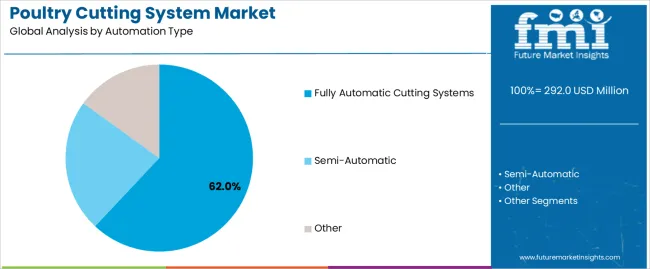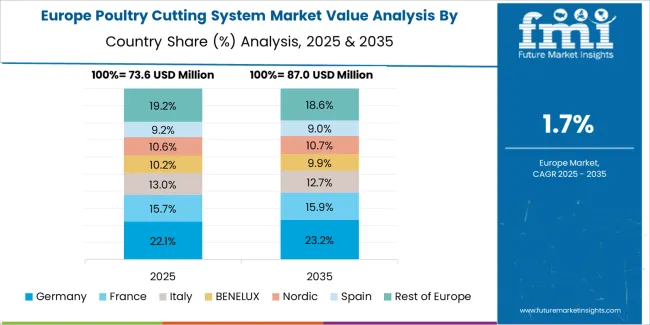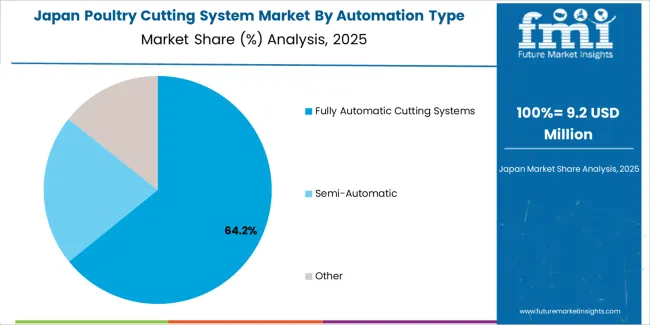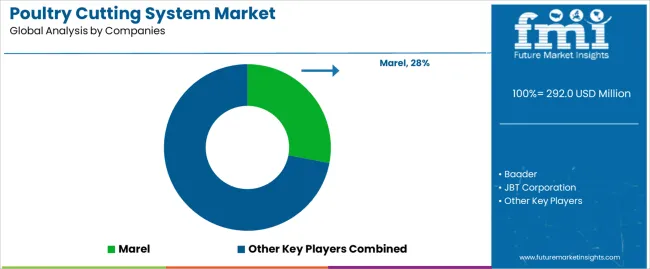The poultry cutting system market is expected to grow from USD 292.0 million in 2025 to USD 352.5 million by 2035, reflecting steady expansion supported by rising poultry consumption, higher processing throughput requirements, and increasing emphasis on standardized meat portioning. Market dynamics are shaped by the shift from manual and semi-automatic butchering practices toward fully automated cutting lines that improve yield accuracy, reduce product handling time, and enhance hygiene compliance inside processing environments. Poultry processors are prioritizing equipment that can maintain consistent cut profiles across varying carcass sizes, while minimizing labor dependence in operations facing workforce shortages and training variability.
Increasing regulatory focus on sanitation, traceability, and contamination control is also driving the adoption of cutting systems with enclosed cutting chambers, CIP-enabled cleaning modules, and real-time visual inspection support. Additionally, the rise of portion-controlled retail packaging and QSR-standardized serving units is reinforcing demand for precision slicing, deboning, and portioning technologies that support downstream packaging automation. As poultry processors expand capacity to serve domestic retail channels and export-grade supply chains, system reliability, maintenance efficiency, and integration with conveyor and chilling lines are becoming defining selection criteria.

The latter half (2030-2035) will witness continued growth from USD 320.8 million to USD 352.5 million, representing an addition of USD 31.7 million or 52% of the decade's expansion. This period will be defined by mass market penetration of high-speed cutting technologies, integration with comprehensive quality management platforms, and seamless compatibility with existing poultry processing infrastructure. The market trajectory signals fundamental shifts in how poultry facilities approach meat production and quality management, with participants positioned to benefit from growing demand across multiple cutting types and capacity segments.
| Period | Primary Revenue Buckets | Share | Notes |
|---|---|---|---|
| Today | New system sales (automatic, semi-automatic) | 48% | Capex-led, capacity-driven purchases |
| Spare parts & consumables | 22% | Blades, cutting tools, consumables for operations | |
| Service & maintenance contracts | 18% | Preventive maintenance, equipment support | |
| Upgrades & retrofits | 12% | Technology enhancement, capacity expansion | |
| Future (3-5 yrs) | High-speed automatic systems | 42-47% | Industry 4.0 integration, smart processing |
| Digital monitoring & analytics | 16-20% | Real-time quality control, predictive maintenance | |
| Service-as-a-subscription | 14-18% | Performance guarantees, outcome-based pricing | |
| Consumables & tooling | 12-16% | Precision blades, specialized cutting tools | |
| Validation & compliance services | 6-10% | Food safety support, digital documentation | |
| Data services (yield optimization, quality metrics, compliance) | 4-7% | Benchmarking for poultry processors |
| Metric | Value |
|---|---|
| Market Value (2025) | USD 292.0 million |
| Market Forecast (2035) | USD 352.5 million |
| Growth Rate | 1.9% CAGR |
| Leading Technology | Fully Automatic Cutting Systems |
| Primary Application | Chicken Segment |
The market demonstrates strong fundamentals with fully automatic cutting systems capturing a dominant share through advanced precision cutting capabilities and poultry processing optimization. Chicken applications drive primary demand, supported by increasing meat consumption and processing capacity requirements. Geographic expansion remains concentrated in developed markets with established poultry processing infrastructure, while emerging economies show accelerating adoption rates driven by local processing initiatives and rising quality standards.
Primary Classification: The market segments by automation type into fully automatic, semi-automatic, and other cutting systems, representing the evolution from basic cutting equipment to sophisticated processing solutions for comprehensive poultry processing optimization.
Secondary Classification: Application segmentation divides the market into chicken, duck, and other poultry sectors, reflecting distinct requirements for processing specifications, operational efficiency, and product quality standards.
Regional Classification: Geographic distribution covers North America, Latin America, Western Europe, Eastern Europe, East Asia, South Asia Pacific, and Middle East & Africa, with developed markets leading adoption while emerging economies show accelerating growth patterns driven by poultry processing expansion programs.
The segmentation structure reveals technology progression from standard cutting equipment toward sophisticated processing systems with enhanced precision and automation capabilities, while application diversity spans from chicken processing facilities to duck processing operations requiring precise cutting solutions.

Market Position: Fully Automatic Cutting Systems command the leading position in the poultry cutting system market with 62% market share through advanced precision features, including superior cutting accuracy, operational efficiency, and poultry processing optimization that enable manufacturing facilities to achieve optimal portion consistency across diverse poultry processing environments.
Value Drivers: The segment benefits from poultry facility preference for reliable cutting systems that provide consistent portioning performance, reduced changeover time, and operational efficiency optimization without requiring significant infrastructure modifications. Advanced design features enable automated quality control systems, weight consistency, and integration with existing poultry processing equipment, where operational performance and food safety compliance represent critical facility requirements.
Competitive Advantages: Fully Automatic Cutting Systems differentiate through proven operational reliability, consistent cutting characteristics, and integration with automated poultry processing systems that enhance facility effectiveness while maintaining optimal quality standards suitable for diverse poultry applications.
Key market characteristics:
Semi-Automatic Cutting systems maintain a 28% market position in the poultry cutting system market due to their balanced precision properties and cost advantages. These systems appeal to facilities requiring moderate processing capacity with competitive pricing for mid-scale poultry applications. Market growth is driven by poultry processing expansion, emphasizing reliable cutting solutions and operational efficiency through optimized system designs.
Other Cutting systems capture 10% market share through specialized cutting requirements in small processing facilities, custom applications, and niche production operations. These facilities demand flexible cutting systems capable of handling diverse poultry types while providing effective cutting capabilities and operational simplicity.

Market Position: Chicken processing commands a significant market position with 70% share, driven by dominant consumption patterns and widespread processing requirements across global poultry markets.
Value Drivers: This application segment provides the primary demand source for cutting systems, meeting requirements for high-volume production, standardized portioning, and diverse product offerings without excessive processing complexity or quality variation.
Growth Characteristics: The segment benefits from broad applicability across food service sectors, standardized processing specifications, and established production programs that support widespread adoption and operational efficiency.
Duck processing applications capture 20% of the market share due to specialized cutting requirements in premium poultry segments and ethnic food markets. These facilities demand precise cutting systems capable of handling unique anatomical characteristics while providing effective portion control and quality consistency.
Other poultry applications account for 10% of the market share, including turkey processing, game bird operations, and specialty poultry requiring customized cutting capabilities for operational optimization and product differentiation.
| Category | Factor | Impact | Why It Matters |
|---|---|---|---|
| Driver | Global poultry consumption growth & protein demand | ★★★★★ | Rising meat demand requires efficient, automated cutting solutions with consistent quality and high-volume processing capabilities. |
| Driver | Food safety regulations & traceability requirements (USDA, EU standards) | ★★★★★ | Turns advanced cutting systems from optional to mandatory; vendors that provide compliance support and documentation gain competitive advantage. |
| Driver | Labor shortage & automation adoption | ★★★★☆ | Processing facilities face skilled worker shortages; automated cutting systems reduce dependency on manual labor while improving consistency. |
| Restraint | High capital investment & installation costs | ★★★★☆ | Small processing companies defer purchases; increases price sensitivity and slows automated equipment adoption in emerging markets. |
| Restraint | Complex sanitation & cleaning requirements | ★★★☆☆ | Multi-product facilities face lengthy cleaning procedures and validation requirements, limiting operational flexibility and increasing downtime. |
| Trend | Industry 4.0 integration & yield optimization | ★★★★★ | Real-time monitoring, predictive maintenance, and data analytics transform operations; connectivity and digital integration become core value propositions. |
| Trend | Product diversification & value-added processing | ★★★★☆ | Flexible cutting systems for specialized products; modular designs and quick changeover capabilities drive competition toward customization solutions. |
The poultry cutting system market demonstrates varied regional dynamics with Growth Leaders including China (2.6% growth rate) and India (2.4% growth rate) driving expansion through poultry processing initiatives and production capacity development. Steady Performers encompass United States (1.8% growth rate), Germany (2.2% growth rate), and developed regions, benefiting from established poultry industries and advanced processing adoption. Emerging Markets feature Brazil (2.0% growth rate) and developing regions, where poultry initiatives and processing modernization support consistent growth patterns.
Regional synthesis reveals East Asian markets leading adoption through poultry expansion and processing development, while North American countries maintain steady expansion supported by processing technology advancement and food safety standardization requirements. European markets show moderate growth driven by poultry applications and quality integration trends.

| Region/Country | 2025-2035 Growth | How to win | What to watch out |
|---|---|---|---|
| China | 2.6% | Lead with high-speed systems | Localization requirements; price competition |
| India | 2.4% | Focus on cost-effective solutions | Infrastructure gaps; cold chain challenges |
| Germany | 2.2% | Offer premium precision systems | Over-engineering; strict regulations |
| Brazil | 2.0% | Value-oriented models | Currency fluctuations; import barriers |
| United States | 1.8% | Provide food safety support | Labor costs; consolidation trends |
| Japan | 1.4% | Push automation solutions | Market maturity; population decline |
China establishes fastest market growth through aggressive poultry processing programs and comprehensive production capacity development, integrating advanced cutting systems as standard components in chicken processing and meat production installations. The country's 2.6% growth rate reflects government initiatives promoting food security and domestic protein production capabilities that mandate the use of advanced cutting systems in poultry processing facilities. Growth concentrates in major processing hubs, including Shandong, Henan, and Liaoning, where poultry technology development showcases integrated cutting systems that appeal to processors seeking advanced production optimization capabilities and quality management applications.
Chinese manufacturers are developing cost-effective cutting solutions that combine domestic production advantages with advanced operational features, including automated quality systems and enhanced precision capabilities. Distribution channels through poultry equipment suppliers and processing service distributors expand market access, while government support for protein production supports adoption across diverse poultry segments.
Strategic Market Indicators:
In Delhi, Maharashtra, and Telangana, poultry facilities and processing plants are implementing advanced cutting systems as standard equipment for production optimization and quality compliance applications, driven by increasing protein consumption and processing modernization programs that emphasize the importance of automation capabilities. The market holds a 2.4% growth rate, supported by government poultry initiatives and processing infrastructure development programs that promote advanced cutting systems for chicken and duck processing facilities. Indian operators are adopting cutting systems that provide consistent operational performance and food safety features, particularly appealing in urban regions where production efficiency and quality standards represent critical operational requirements.
Market expansion benefits from growing poultry processing capabilities and technology transfer agreements that enable domestic production of advanced cutting systems for meat processing applications. Technology adoption follows patterns established in food processing equipment, where reliability and performance drive procurement decisions and operational deployment.
Market Intelligence Brief:
Advanced food processing technology market in Germany demonstrates sophisticated cutting system deployment with documented operational effectiveness in poultry applications and processing facilities through integration with existing quality systems and food safety infrastructure. The country leverages engineering expertise in food processing technology and quality systems integration to maintain a 2.2% growth rate. Industrial centers, including Lower Saxony, North Rhine-Westphalia, and Bavaria, showcase premium installations where cutting systems integrate with comprehensive processing platforms and facility management systems to optimize production operations and quality effectiveness.
German manufacturers prioritize system precision and EU compliance in cutting equipment development, creating demand for premium systems with advanced features, including facility monitoring integration and automated quality systems. The market benefits from established food processing technology infrastructure and a willingness to invest in advanced processing technologies that provide long-term operational benefits and compliance with international food safety standards.
Market Intelligence Brief:
Brazil's market expansion benefits from diverse poultry demand, including processing modernization in Santa Catarina and Parana, poultry facility upgrades, and government agricultural programs that increasingly incorporate cutting solutions for production optimization applications. The country maintains a 2.0% growth rate, driven by rising poultry activity and increasing recognition of cutting technology benefits, including precise portion control and enhanced production efficiency.
Market dynamics focus on cost-effective cutting solutions that balance advanced operational performance with affordability considerations important to Brazilian poultry processors. Growing poultry industrialization creates continued demand for modern cutting systems in new facility infrastructure and processing modernization projects.
Strategic Market Considerations:

United States establishes market leadership through comprehensive poultry programs and advanced processing infrastructure development, integrating cutting systems across chicken and turkey applications. The country's 1.8% growth rate reflects established poultry industry relationships and mature cutting technology adoption that supports widespread use of precision cutting systems in processing facilities. Growth concentrates in major poultry centers, including Georgia, Arkansas, and North Carolina, where processing technology showcases mature cutting deployment that appeals to processors seeking proven precision cutting capabilities and operational efficiency applications.
American equipment providers leverage established distribution networks and comprehensive service capabilities, including validation programs and maintenance support that create customer relationships and operational advantages. The market benefits from mature food safety standards and processing requirements that mandate cutting system use while supporting technology advancement and operational optimization.
Market Intelligence Brief:
United Kingdom's poultry processing market demonstrates established cutting system deployment with documented operational effectiveness in chicken applications and processing facilities through integration with existing quality systems and food safety infrastructure. The country maintains a 1.6% growth rate. Processing centers, including East Anglia, Yorkshire, and West Midlands, showcase installations where cutting systems integrate with comprehensive processing platforms and facility management systems to optimize production operations and quality effectiveness.
British processors prioritize food safety compliance and operational efficiency in cutting equipment procurement, creating demand for systems with advanced features, including traceability integration and automated quality systems. The market benefits from established poultry processing infrastructure and post-Brexit food standards that support technology advancement and operational optimization.
Market Intelligence Brief:

The European poultry cutting system market is projected to grow from USD 107.0 million in 2025 to USD 139.5 million by 2035, registering a CAGR of 2.7% over the forecast period. Germany is expected to maintain its leadership position with a 35.8% market share in 2025, supported by its advanced food processing technology infrastructure and major poultry processing centers.
United Kingdom follows with a 22.1% share in 2025, driven by comprehensive poultry programs and processing technology development initiatives. France holds a 18.4% share through specialized poultry applications and food safety compliance requirements. Italy commands a 12.9% share, while Spain accounts for 10.8% in 2025. The rest of Europe region is anticipated to gain momentum, expanding its collective share from 6.3% to 6.8% by 2035, attributed to increasing poultry cutting system adoption in Nordic countries and emerging Eastern European facilities implementing processing modernization programs.

Japan's poultry cutting system market demonstrates sophisticated deployment with documented operational effectiveness in chicken processing applications through integration with existing quality systems and food safety infrastructure. The country maintains a 1.4% growth rate, supported by established poultry processing operations and premium product requirements. Processing centers showcase advanced cutting system installations where precision cutting capabilities and quality management features align with Japanese food safety standards and consumer quality expectations.
Japanese processors prioritize system reliability and food safety compliance in cutting equipment procurement, creating demand for premium systems with advanced automation features. The market benefits from established quality standards and mature processing infrastructure, though demographic trends and market saturation moderate growth potential compared to emerging Asian markets.

South Korea's poultry cutting system market demonstrates quality-focused adoption with emphasis on precision processing and food safety compliance across chicken processing operations. The market maintains steady growth driven by urban consumption patterns and quality requirements. Processing facilities in Gyeonggi and South Chungcheong provinces showcase modern cutting system installations where automation capabilities and quality management features support premium product positioning and export competitiveness in Asian markets.

The poultry cutting system market features 12-15 credible players with top 5 companies holding approximately 68-72% market share by revenue. Leadership is maintained through service networks, food safety compliance support, and technology innovation focused on cutting speed, precision, and digital integration capabilities.
Structure: Market concentration reflects established equipment manufacturers with proven processing technology and comprehensive service capabilities. Regional players maintain presence through localized support networks and cost-competitive offerings, while global leaders leverage technology innovation and extensive distribution infrastructure.
Leadership is maintained through: extensive service networks, food safety validation support, and technology innovation emphasizing processing speed, cutting precision, yield optimization, and digital monitoring integration.
What's commoditizing: basic cutting mechanisms and standard monitoring dashboards face increasing price pressure as technology matures and alternative suppliers emerge with comparable performance specifications.
Margin Opportunities: validation services, spare parts availability, and integration into customer workflows including MES/ERP systems, digital batch records, and yield management platforms provide differentiation beyond equipment sales.
| Stakeholder | What they actually control | Typical strengths | Typical blind spots |
|---|---|---|---|
| Global platforms | Distribution reach, deep product catalogs, service depots | Broad availability, proven reliability, multi-region support | Technology refresh cycles; customer lock-in dependency |
| Technology innovators | R&D capabilities; high-speed/precision systems; clean digital interfaces | Latest features first; attractive ROI on high-volume production | Service density outside core regions; customization complexity |
| Regional specialists | Local compliance, fast delivery, nearby technicians | Close to site support; pragmatic pricing; local regulations | Technology gaps; talent retention in service |
| Service-focused ecosystems | Validation support, maintenance SLAs, spare parts availability | Lowest real downtime; comprehensive support | Service costs if overpromised; technology obsolescence |
| Niche specialists | Specialized applications, custom solutions, small batch support | Win specialty/ethnic processing; flexible configurations | Scalability limitations; narrow market focus |
Market dynamics favor equipment providers demonstrating comprehensive food safety compliance capabilities, rapid service response networks, and proven integration with existing processing infrastructure. Technology advancement focuses on yield optimization through precise cutting control, digital monitoring for quality assurance, and seamless connectivity with processing management systems. Competitive differentiation increasingly relies on service capabilities and digital features rather than basic cutting performance specifications.
| Item | Value |
|---|---|
| Quantitative Units | USD 292 million |
| Automation Type | Fully Automatic, Semi-Automatic, Other |
| Application | Chicken, Duck, Other |
| Regions Covered | North America, Latin America, Western Europe, Eastern Europe, East Asia, South Asia Pacific, Middle East & Africa |
| Countries Covered | China, India, Germany, Brazil, United States, United Kingdom, Japan, South Korea, and 15+ additional countries |
| Key Companies Profiled | Marel, Baader, JBT Corporation, Foodmate, Meyn, Mayekawa, Cantrell Gainco Group, Bayle S.A., Qingdao Ruizhi Intelligent Equipment Technology |
| Additional Attributes | Dollar sales by automation type and application categories, regional adoption trends across East Asia, South Asia Pacific, and Western Europe, competitive landscape with poultry processing equipment manufacturers and food processing suppliers, poultry operator preferences for precision cutting control and system reliability, integration with processing platforms and quality monitoring systems, innovations in cutting technology and precision enhancement, and development of automated cutting solutions with enhanced performance and poultry processing optimization capabilities. |
The global poultry cutting system market is estimated to be valued at USD 292.0 million in 2025.
The market size for the poultry cutting system market is projected to reach USD 352.5 million by 2035.
The poultry cutting system market is expected to grow at a 1.9% CAGR between 2025 and 2035.
The key product types in poultry cutting system market are fully automatic cutting systems , semi-automatic and other.
In terms of application, chicken segment to command 70.0% share in the poultry cutting system market in 2025.






Full Research Suite comprises of:
Market outlook & trends analysis
Interviews & case studies
Strategic recommendations
Vendor profiles & capabilities analysis
5-year forecasts
8 regions and 60+ country-level data splits
Market segment data splits
12 months of continuous data updates
DELIVERED AS:
PDF EXCEL ONLINE
Poultry Diagnostic Testing Market Size and Share Forecast Outlook 2025 to 2035
Poultry Farming Equipment Market Size and Share Forecast Outlook 2025 to 2035
Poultry Feeder Market Size and Share Forecast Outlook 2025 to 2035
Poultry Processing Equipment Market Size and Share Forecast Outlook 2025 to 2035
Poultry Seasoning Market Size, Growth, and Forecast for 2025 to 2035
Poultry Diagnostics Market - Demand, Growth & Forecast 2025 to 2035
Poultry Packaging Market Insights - Trends & Future Outlook 2025 to 2035
Poultry Vitamins Market Analysis - Size, Share & Forecast 2025 to 2035
Poultry Brooder Market Trend Analysis Based on Type, Operation, Poultry, Distribution Channel, and Region 2025 to 2035
Poultry Feed Market Analysis by Livestock, Nature, Feed Type, Form, and Region from 2025 to 2035
Poultry Keeping Machinery Market Growth - Trends & Forecast 2025 to 2035
Poultry Meal Market – Growth, Demand & Nutritional Benefits
Poultry Concentrate Market
Meat, Poultry, and Seafood Packaging Market Size and Share Forecast Outlook 2025 to 2035
Market Share Breakdown of Meat, Poultry, and Seafood Packaging Manufacturers
Rendered Poultry Products Market Analysis by Type and Grade Through 2035
Precision Poultry Nutrition Market – Growth, Demand & Livestock Trends
Cutting Tool Packaging Market Size and Share Forecast Outlook 2025 to 2035
Cutting Boards Market Size and Share Forecast Outlook 2025 to 2035
Cutting and Bending Machine Market Size and Share Forecast Outlook 2025 to 2035

Thank you!
You will receive an email from our Business Development Manager. Please be sure to check your SPAM/JUNK folder too.
Chat With
MaRIA